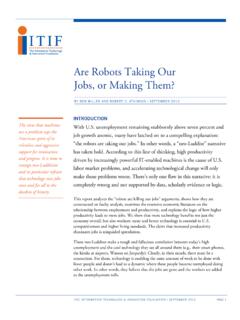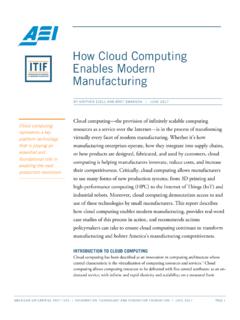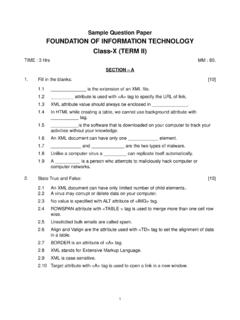Transcription of President-Elect Trump's Positions on Technology and ...
1 PAGE 1 information Technology & INNOVATION FOUNDATION | NOVEMBER 2016 President-Elect trump s Positions on Technology and Innovation Policy BY ITIF STAFF | NOVEMBER 2016 Technological innovation has long been and will continue to be critically important to both income growth and national competitiveness. So it is important that we examine President-Elect Donald trump s policy agenda through that This report is based on information gathered directly from the President-Elect s campaign websites and policy documents, and from media accounts of statements he has made. The report begins with an overview of the general philosophy the President-Elect has articulated on Technology , innovation, and trade policy, then examines his policy Positions across eight specific issue areas: Innovation and R&D Regulation Education and Skills Broadband and Telecommunications Taxes and Budget Internet and Digital Economy Trade Life Sciences and Biotechnology GENERAL PHILOSOPHY TOWARD Technology AND INNOVATION POLICY During the campaign, President-Elect trump largely focused on issues other than Technology and innovation policy.
2 And when he spoke about the tech industry, his comments occasionally were critical. In general, there were few articulated policy Positions , especially outside of the tax and trade area. As of early August, there were just six policy Positions listed under the Positions tab of the official trump campaign A separate Issues area of the site consisted of only about 20 short videos (most less than a minute in length) in which trump discussed his agenda, but the videos that could be related to innovation ( , jobs, education, and the economy ) provided only broad brushstrokes and no specific mention of T he trump campaign site did provide some detail about his position on China, which would have the federal government take a much stronger position on issues such as currency manipulation and intellectual This report provides an overview of the general philosophy that the President-Elect has articulated on Technology , innovation, and trade policy, then examines his policy Positions across eight specific issue areas.
3 PAGE 2 information Technology & INNOVATION FOUNDATION | NOVEMBER 2016 property theft. In an August 8 speech at the Detroit Economic Club, Mr. trump also offered details on his economic plan, which includes reducing the corporate tax rate to 15 percent, allowing unlimited first-year expensing on all equipment, taxing foreign source income that is repatriated at 10 percent, and significantly reducing federal regulation. Table 1: The President-Elect s General Philosophies Toward Technology and Innovation Policy General Philosophies Generally conservative position of significantly reducing business taxes and regulations, including a significant reduction of corporate taxes. Unclear position on high-skill immigration. Supports strong homeland security with potential effects on weakening encryption. Would strengthen trade enforcement, including by renegotiating existing trade deals. Innovation and R&D Among nations, a fierce race for global innovation leadership has Countries increasingly recognize the importance of coordinated national innovation and R&D strategies in driving growth and spurring the competitiveness of their enterprises, which explains why more than four dozen countries have now created national innovation strategies and/or launched national innovation But as ITIF found in a comparative analysis of 56 leading nations, policies are only the world s 10th-best (on a per capita basis) at proactively contributing to global That s in large part because the government underinvests in R&D relative both to historical norms and to peer nations (on a per capita basis) and also because the United States increasingly offers less attractive incentives for R&D activity.
4 In fact, the R&D tax incentive is now only the world s 27th most While, as a nation, the United States continues to invest the most annually in scientific research in absolute terms, the country has slipped to just ninth among OECD nations in terms of research expenditures per Much of this is due to cuts in federal funding of R&D. In fact, federal funding for R&D as a share of GDP in 2016 will be the lowest it has been since the Russians launched Sputnik, almost 50 years And faltering federal R&D funding also explains why the United States has fallen to just 24th out of 39 OECD nations in government funding of university R& In fact, to restore the federal R&D to GDP ratio to average levels in the 1980s, the federal government would need to invest $65 billion more per This matters because federal R&D funding is crucially important to innovation, as ITIF has documented in Among nations, a fierce race for global innovation leadership has emerged.
5 PAGE 3 information Technology & INNOVATION FOUNDATION | NOVEMBER 2016 numerous But so are a host of other policies to support innovation, including patent reform, and tech transfer. Table 2: The President-Elect s Positions on Innovation and R&D Policy Issue position Federal R&D Funding No position . However, has signaled a desire to direct funding to current challenges (such as infrastructure) as opposed to future-oriented scientific research or missions (such as space-related research).13 Technology Transfer and Commercialization No position . Supporting Start-ups and Small Businesses No position . Patent System Reform No position . Education and Skills If America is to succeed in the innovation-powered global economy, then it is vital to boost education in the so-called STEM subjects of science, Technology , engineering, and Yet the United States needs to bring a much-needed dose of innovation to STEM education policy, including moving from the current some STEM for all to an all STEM for some approach.
6 One key way to bolster STEM education is through the creation of more math and science high One of the long-standing strengths of the national innovation system has been its ability to use scientific and technological talent effectively, regardless of its The global talent imperative requires that the United States implement policies that will both produce a domestic workforce equipped with globally demanded skills and be open to skilled foreign workers who wish to pursue their talents in the environment of economic opportunity the United States affords. Table 3: The President-Elect s Positions on Education and Skills Policy Issue position Immigration of High-Skill Foreign Workers In the campaign, Mr. Trumps opposed H-1B visas, calling guest workers cheap substitutes for American He proposed requiring companies to hire from an unemployed The United States needs to bring a much-needed dose of innovation to STEM education policy, including moving from the current some STEM for all to an all STEM for some approach.
7 PAGE 4 information Technology & INNOVATION FOUNDATION | NOVEMBER 2016 pool, and suggested raising wage requirements for H-1B workers. Has stated that he is for high-skilled immigration, despite opposition to H-1B program specifically. Support for STEM Education Has suggested tying student loan decisions to job prospects after graduation, which would promote STEM majors with high expected Argues that there is no shortage of skilled STEM workers because some STEM graduates do not find jobs in their Supporting Innovation in Education Calls for education to be locally driven. Is against the Common Core, and has stated that he will dismantle Taxes and Budget Governments can spur innovation by creating a favorable climate for private sector investment that makes the corporate tax code more competitive with other nations and also leverages tax policy to incent private sector R&D and investment.
8 As ITIF has argued, the corporate tax code should explicitly promote the international competitiveness of American businesses and encourage innovation by providing incentives for the drivers of productivity and innovation: investment in R&D; new capital equipment, especially information and communications Technology ; and workforce education and Unfortunately, America now has the highest combined federal-state statutory corporate tax rate among OECD countries, at It is the only OECD country in which the statutory corporate tax rate did not decline between 2000 and Moreover, even as an increasing number of countries use R&D tax incentives as a key component of their innovation-led economic development strategies, the United States fell from providing the most generous R&D tax incentive among OECD countries in the late 1980s, to ranking 17th in 2004, and 27th in Brazil, China, and India each offer more generous R&D tax credits than the United States.
9 The United States should also bring more innovation to its tax code by introducing more collaborative R&D tax credits and by taxing revenues from newly patented products at preferential The corporate tax code should explicitly promote the international competitiveness of American businesses and encourage innovation. PAGE 5 information Technology & INNOVATION FOUNDATION | NOVEMBER 2016 Table 4: The President-Elect s Positions on Tax Policy Issue position Corporate Tax Rates Would reduce rate to 15 End deferral of tax on foreign Reduce or eliminates corporate loopholes that cater to special interests. 28 Phase in a reasonable cap on the deductibility of interest Immediate expensing for all new business Repeal corporate alternative minimum Deemed Repatriation Taxes past foreign profits held in cash at 10 Tax Rate on Foreign Earnings Lower rate to 15 Eliminate deferral of Innovation Box No position .
10 R&D Tax Credit No position . Accelerated Depreciation No position . Individual Rate Create three brackets with a top rate of 33 Eliminate marriage Eliminate Alternative Minimum Pass-through entities pay 15 percent personal income tax on business Eliminate estate Reduce or eliminate most deductions and loopholes available to the very rich. 40 PAGE 6 information Technology & INNOVATION FOUNDATION | NOVEMBER 2016 Steepen the curve for phasing out the personal exemption and the Pease limitation on itemized Phase out exemption on life-insurance interest for high-income Eliminate percent net investment Allow a full deduction for the average cost of child Capital Gains Rate Tax capital gains and dividends at a top rate of 20 Carried Interest End carried Trade With much of the economy based on innovation, where firms have relatively high fixed costs and lower marginal costs, the right trade policy is essential to ensuring open and fair access to global markets, as this spurs productivity, innovation, and But global trade is at a crossroads multilateral trade negotiations have collapsed while a growing number of countries enact protectionist policies.













